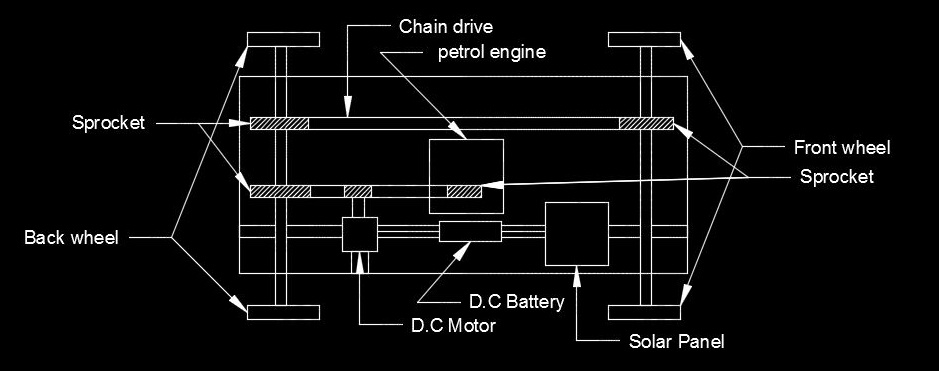





Published on Sep 03, 2023
The progress of automobiles for transportation has been intimately associated with the progress of civilization. The automobile of today is the result of the accumulation of many years of pioneering research and development. In the modern trend automobiles have certain disadvantages soon as fuel cost relative to mileage, pollution and less efficiency.
To improve Efficiency
To decrease the fuel cost relative to mileage.
To control the pollution is to be effect.
Then our “HYBRID VECHILE” is an aspect. The goal of this project was to implement the most efficient and less polluting vehicle. In our project the hybrid electric vehicle model combines the internal combustion engine of a conventional vehicle with the battery and electric motor of an electric vehicle, resulting in twice the fuel economy of conventional vehicle. That is model get energy in solar energy conversion it is saved battery then using drive to motor. We implement this hybrid electric vehicle concept for four wheelers.
Since the last two decades the judiciary and policy makers all over the world are deeply concerned about the urgent need for protection of the environment, ecology and humanity at large, there has been a steep rise in the accumulation of green house gases particularly CO₂, which effect global changes in weather. Motor vehicle contribute about 14% of CO₂ from all sources besides, pollution due to both petrol and diesel engine driven vehicles caused by the emission of CO, no unburnt hydrocarbons, particulate and oxides of tetra ethyl, Lead are injury to health and environment.
Regulations on exhaust emission from vehicle engines have been made progressively more and more stipend towards the year 2000 and beyond, Vehicle manufactures have been hence obliged to meet these standards by designing cleaner and fuel efficiently engines and through provision for treatment of exhaust gases to satisfy the specified limits. So to satisfy and overcome these two problems namely
Pollution and
Efficiency
Then we go for a hybrid vehicle
The working principle of hybrid vehicle basically involves two processes, the first process involves when the vehicle is running by means of internal combustion engine and the second process involves when the vehicle is running by means of an electric motor. When the vehicle is driven at the outside of city the vehicle is powered by means of internal combustion engines. The power from the engine is taken from the pulley and then it rotates the wheel. During this process the vehicle is charged by means of a generator used. The power is generated through generator is by connecting the generator shaft with the shaft of the wheel by means of V-Belt.
When the vehicle is driven inside the city, the vehicle is powered by means of a motor. The power to run the motor is supplied from the battery, as the battery is already charged when the vehicle running on the internal combustion engine. During this process the speed of the vehicle will be minimum and there is no smog forming pollutants produced during the vehicle runs. When the vehicle is powered by means of electric motor the power from the internal combustion engine will be disconnected from the shaft by loosening the belt. The mileage of the vehicle while running on the electric motor is mainly depends upon the time of charging and also depends upon the capacity of the battery.
In this process the motor cum generator serves as motor as well as generator. It serves as a motor when the vehicle is running by means of battery and it serves as a generator when the vehicle is running by means of internal combustion engine it is combined to solar energy it will be getting on saved to the battery.
HEVs have several advantages over conventional vehicle:
Regenerative breaking capability helps minimize energy loss and recover the energy used to slow down or step a vehicle.
Engines can be sized to accommodate average load, not peak load, which reduces the engine’s weight.
Fuel efficiency is greatly increased (Hybrids consume significantly less fuel than vehicles powered by gasoline alone)
Emissions are greatly decreased.
HEVs can reduce dependency on fossil fuels because they can run on alternative fuels.
Special lightweight materials are used to reduce the overall vehicle weight of HEVs. The HEVs available for sale are very cost competitive with similar conventional vehicles. Any cost premium that may be associated with HEVs of the future can be off-set by overall fuel savings and possible incentives.
Auto manufactures are making these HEVs with comparable performance, safety, and cost because they know that these three elements are most important to consumers. Any by combining gasoline with electric power, hybrids will have the same or greater range than traditional combustion engines. The HEVs is able to operate approximately two times more efficiently than conventional vehicle. Honda’s Insight can go 700 miles on a single tank of gas. The Toyota Prius can go about 500 miles. For the driver, hybrids offer similar or better performance than conventional vehicles.
